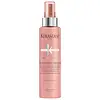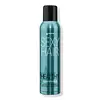What's inside
What's inside
 Key Ingredients
Key Ingredients

No key ingredients
 Benefits
Benefits

 Concerns
Concerns

 Ingredients Side-by-side
Ingredients Side-by-side

Water
Skin ConditioningAmodimethicone
PEG-40 Hydrogenated Castor Oil
EmulsifyingTrideceth-5
EmulsifyingPolyquaternium-37
Phenoxyethanol
PreservativePropylene Glycol Dicaprylate/Dicaprate
EmollientGlycerin
HumectantTocopherol
AntioxidantArginine
MaskingPhenyl Trimethicone
Skin ConditioningTrideceth-10
CleansingLactic Acid
BufferingPPG-1 Trideceth-6
Skin ConditioningChlorhexidine Digluconate
AntimicrobialSorbitan Oleate
EmulsifyingAcetic Acid
BufferingQuaternium-87
CleansingSodium Hyaluronate
HumectantCentella Asiatica Extract
CleansingTartaric Acid
BufferingLinalool
PerfumingPropylene Glycol
HumectantLimonene
PerfumingGeraniol
PerfumingHydroxycitronellal
PerfumingParfum
MaskingCeramide AP
Skin ConditioningWater, Amodimethicone, PEG-40 Hydrogenated Castor Oil, Trideceth-5, Polyquaternium-37, Phenoxyethanol, Propylene Glycol Dicaprylate/Dicaprate, Glycerin, Tocopherol, Arginine, Phenyl Trimethicone, Trideceth-10, Lactic Acid, PPG-1 Trideceth-6, Chlorhexidine Digluconate, Sorbitan Oleate, Acetic Acid, Quaternium-87, Sodium Hyaluronate, Centella Asiatica Extract, Tartaric Acid, Linalool, Propylene Glycol, Limonene, Geraniol, Hydroxycitronellal, Parfum, Ceramide AP
Hydrofluorocarbon 152a
Alcohol Denat.
AntimicrobialIsobutane
Neopentyl Glycol Diheptanoate
EmollientDisiloxane
Skin ConditioningC12-15 Alkyl Benzoate
AntimicrobialIsododecane
EmollientPEG-12 Dimethicone
Skin ConditioningParfum
MaskingEthyl Ester Of Hydrolyzed Silk
Skin ConditioningPanthenyl Ethyl Ether
Benzoic Acid
MaskingPropylene Glycol
HumectantPhytantriol
HumectantLinalool
PerfumingGeraniol
PerfumingHexyl Cinnamal
PerfumingIngredients Explained
These ingredients are found in both products.
Ingredients higher up in an ingredient list are typically present in a larger amount.
Geraniol is used to add fragrance/parfum to a product. It is the main component of citronellol. It is a monoterpenoid and an alcohol.
Monoterpenes are naturally found in many parts of different plants.
Geraniol can be found in many essential oils including Rose Oil and Citronella Oil. The scent of Geraniol is often described as "rose-like". Many foods also contain Geraniol for fruit flavoring.
Geraniol can irritate the skin when exposed to air. However, irritation depends on the ability of geraniol to penetrate into the skin. In general, geraniol is not able to penetrate skin easily.
Geraniol is colorless and has low water-solubility. However, it is soluble in common organic solvents.
Like citronellol, it is a natural insect repellent.
2,6-Octadien-1-ol, 3,7-dimethyl-, (2E)-
Learn more about GeraniolLinalool is a fragrance and helps add scent to products. It's derived from common plants such as cinnamon, mint, citrus, and lavender.
Like Limonene, this ingredient oxidizes when exposed to air. Oxidized linalool can cause allergies and skin sensitivity.
This ingredient has a scent that is floral, spicy tropical, and citrus-like.
Learn more about LinaloolParfum is a catch-all term for an ingredient or more that is used to give a scent to products.
Also called "fragrance", this ingredient can be a blend of hundreds of chemicals or plant oils. This means every product with "fragrance" or "parfum" in the ingredients list is a different mixture.
For instance, Habanolide is a proprietary trade name for a specific aroma chemical. When used as a fragrance ingredient in cosmetics, most aroma chemicals fall under the broad labeling category of “FRAGRANCE” or “PARFUM” according to EU and US regulations.
The term 'parfum' or 'fragrance' is not regulated in many countries. In many cases, it is up to the brand to define this term.
For instance, many brands choose to label themselves as "fragrance-free" because they are not using synthetic fragrances. However, their products may still contain ingredients such as essential oils that are considered a fragrance by INCI standards.
One example is Calendula flower extract. Calendula is an essential oil that still imparts a scent or 'fragrance'.
Depending on the blend, the ingredients in the mixture can cause allergies and sensitivities on the skin. Some ingredients that are known EU allergens include linalool and citronellol.
Parfum can also be used to mask or cover an unpleasant scent.
The bottom line is: not all fragrances/parfum/ingredients are created equally. If you are worried about fragrances, we recommend taking a closer look at an ingredient. And of course, we always recommend speaking with a professional.
Learn more about ParfumPropylene Glycol is an odorless, colorless liquid. As a humectant, it helps skin retain moisture. It also aids in delivering active ingredients.
Another role of this ingredient is preventing a product from melting or freezing. Propylene glycol also adds antimicrobrial properties to a product, elongating product lifespan.
This ingredient is considered an organic alcohol and commonly added into both cosmetics and foods.
Those with sensitive skin or conditions may develop a rash when using this ingredient.
Learn more about Propylene Glycol